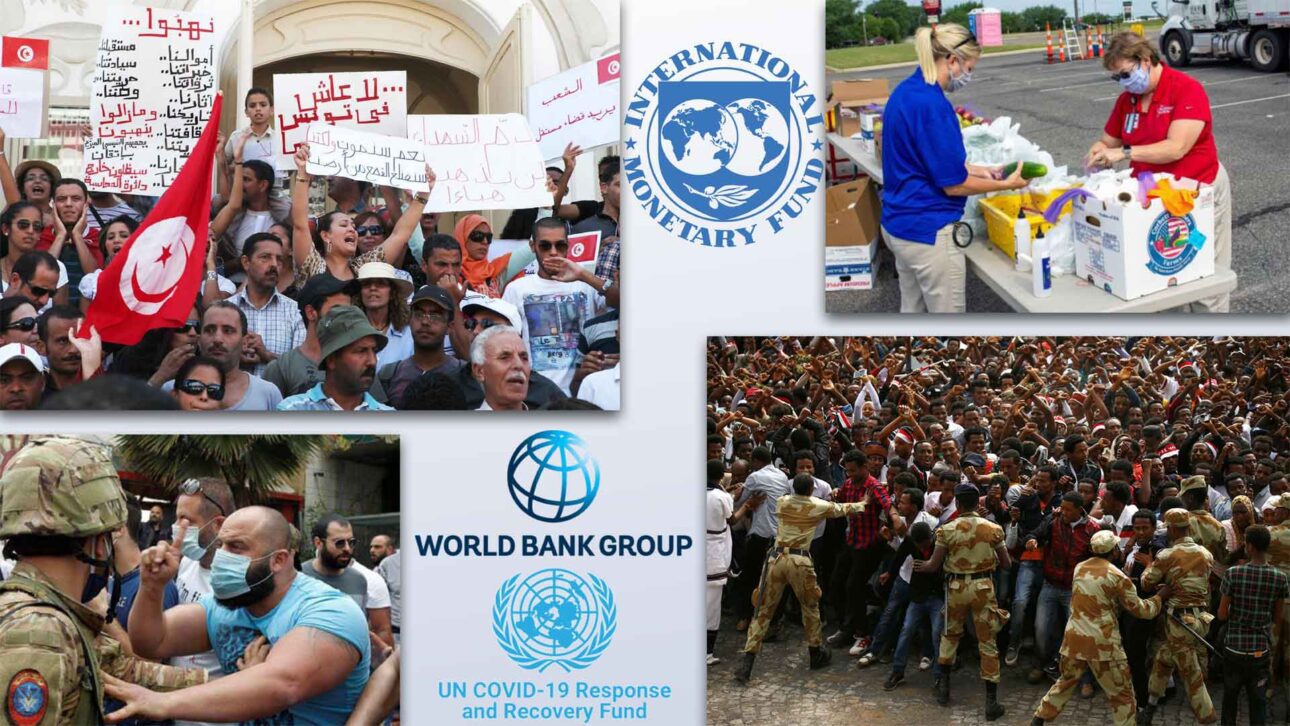
The developing countries all over the world are suffering from a sovereign debt crisis never witnessed before. One of these countries, Sri Lanka, has already succumbed to it.
Having $7 billion in debt repayments due this year but less than $3 billion in foreign currency reserves, it is struggling with its worst financial crisis triggered by global shock waves from the COVID-19 pandemic and the war in Ukraine, according to media reports. More countries are about to fall. The entire developing world is in danger of a complete collapse. PTI reporters said: “Inflation rate spiraling towards 40%, shortages of food, fuel and medicines and rolling power blackouts have led to nationwide protests and a plunging currency.”
Source: https://www.indiatvnews.com/news/world/sri-lanka-defaults-on-debt-first-time-economic-crisis-deepens-2022-05-20-778020
A block of at least 69 countries are facing the 3 major risks: Food, Energy and Economy. All these 69 countries are heading to the destiny of Sri Lanka. Out of these we can count 25 in Africa, 25 in Asia and the Pacific and 19 in Latin America.
A global crisis led to the collapse of the economy of Sri Lanka. Several other countries are on their way to the same scenario.
Let’s talk about Lebanon, which was the Switzerland of the Middle East. In 2020 the Beirut blast has destroyed its biggest grain stores. Food went up by 11 times, the Lebanese Pound lost 90% of its value … “At the time of the default in March 2020, Lebanon’s public debt had reached over USD 90 billion, equivalent to around 170% of its GDP, with close to 37% of the debt in foreign currency.”
Source: https://www.businesstimes.co/2021/09/23/lebanons-public-debt-default/
Since then, public debt grew to 360% of the GDP and the war in Ukraine complicated the situation further as it imports 80% of its wheat from Ukraine. Those supplies have fallen leading to wheat shortage and people are already queuing for bread, not to mention the scarcity of sunflower oil. Lebanon was forced to seek relief through USD 150m loan from the World Bank to guarantee its food security.
Egypt may be the following one and then Tunisia.
Egypt, the land of the Pharaohs, is in the middle of a “silent debt crisis”. It is the world’s largest wheat importer. Russia and Ukraine were its biggest exporters based on a barter trading system that was perfectly tailored for their commercial exchanges. The wheat reserves are running out as the two countries were fighting now for the last 2 months. Last month, President Sissi said that Egypt wheat reserves are covered for the next 6 months. Last week, wheat reserves were said to cover not more than the next 3 months.
Next comes Tunisia, the country in which the Arab Spring was born. Its economy is overheating, going from bad to worse through a severe crisis aggravated by a political gear and a lack of management efficiency. Its foreign debt level has reached 100% of its GDP. The trade deficit has reached USD 800m, inflation 7%, fuel prices are at record height and experts say that Tunisia could soon face civil unrest movements with unemployment at 17.8% according to the State Statistics Institute.
Source: https://www.reuters.com/world/africa/tunisias-political-crisis-threatens-deepen-economic-troubles-2021-09-27/
In addition to this economic severe crisis, the Tunisian democratic transition that was supposed to be led by its new president seems to be far from being on the good path and the traditional active political partners are simply excluded from the reform’s process, so far.
What is the Solution?
Already the “IMF determined early in 2020 that 29 of its most vulnerable developing members will be exempted from amortization and interest on their debts with the organization, during an initial period of six months that was later extended to 24 months (until April 13, 2022)” as a further COVID-19 support.
Source: https://www.brookings.edu/blog/future-development/2021/03/08/managing-developing-countries-sovereign-debt/
This solution does not substitute long-term solutions necessary to address the systemic risks and governance challenges of their latest sovereign crisis. The 3 risks are still there and populations are queuing for bread. At least, 31 people were killed this Saturday, 28 May in a stampede in Southern Nigeria during a food distribution organized by a church, police said. Governments of developing countries are being stormed by unrest movements, risking to be overthrown sometimes by their armies.
In fact, this is a structural crisis that needs to be addressed by a structural solution, which is beyond the limited IMF “tools” we are used to, such as debt restructuring mechanisms and austerity measures known mostly under the Structured Adjustment Programs (SAPs). The SAP was implemented for instance in Sudan, mainly from the 1989-2019 period and in many other developing countries leading to catastrophic impacts on already very vulnerable societies. These policies and the IMF’s role in implementing the SAPs have been heavily criticized by developing country governments and development organizations as having worsened the situation of poor and lower-income people, as well as contributing to the degradation of the natural environment.
Source: https://www.researchgate.net/publication/348607192_Assessment_the_Structural_Adjustment_Policies_in_Sudan_via_VECM_Model_through_the_period_1989-2019
In her article of Sept. 2021, Alicia García Herrero, a Chief Economist for Asia Pacific at NATIXIS, suggested to create a World Recovery Fund (WRF) that should enable most vulnerable countries to swap their old debts for new debts and/or to issue new ones under improved market conditions, conditioned by underlying projects as collateral and based on guarantees from highly rated countries and/or large private creditors to developing countries. This swap is supposed to have a better credit rating than the beneficiary developing countries’, thus allowing a swap of higher-risk and costly sovereign debt securities issued by a developing country with a less costly supranational loan provided by the WRF.
WRF solution will only postpone the big collapse and differ it for the next 10-20 years, with more working commissions to establish, more experts’ salaries to pay on the detriment of already starving populations, as usual.
We must, however, dare a third way to face this vicious circle. One approach would be to conduct an integral debt auditing preceded by a suspension of repayment, as requested for a long time by the Tunisian civil society, to take advantage of the Arab Spring event in order to sort out the real debts from the bad ones that were received directly by the former officers on their bank accounts abroad in bribes and commissions. That would have resulted in excluding a significant burden of miss-allocated debts as a significant haircut to use it as new financial resources by the government to increase its social expenditure in the fields of healthcare, education, social assistance and in the development, as was the case in Ecuador in 2007.
Source: https://internationalviewpoint.org/IMG/pdf/restructuration-audit-suspension-and-abolition-of-the-debt_a4107.pdf
In the context of the increasing power of international finance, we need to “think structurally” and to “act temporally”. That means we must also “delink” the financial and development strategies of the developing countries from the rich countries’ financial and monetary mechanisms. Thinking creatively for long-term solutions would definitely lead to think out of the Bretton Woods and Club de Paris boxes.
An urgent prioritization of the affected countries’ domestic economies over the global ones to resolve the gear of the financial and monetary dependencies is required. We are talking here about the monetary sovereignty, the decolonization of developing countries’ development and most importantly: the cancellation of their public debts by their former/neo-colonisers in recognition of the heavy, ugly, destructive and devastating colonialist legacy still perpetuated through those monetary and financial institutions.
This would require the establishment of new partnerships based on a win-win monetary and financial approach. That new monetary approach would empower again the “Nation State” autonomy towards appropriate and tailored-made financial and sustainable development solutions, really in line with the local economic needs to carry out the developing countries’ own Millennium Development Goals, and mainly the Goal 8, stating: “Promote sustained, inclusive and sustainable economic growth, full and productive employment and decent work for all … and enhanced debt relief for heavily indebted poor countries, …”
Source: https://sdgs.un.org/goals/goal8
My solution may be radical. Otherwise, the global collapse of the public debt will be terrifying not only for the developing countries … and this sovereign debt crisis will be the largest in a generation where Sri Lanka and Lebanon may be just the beginning, not saying where it ends! …
Hayet Bouzid
Email: Info@LadyExpertInvestor.com

